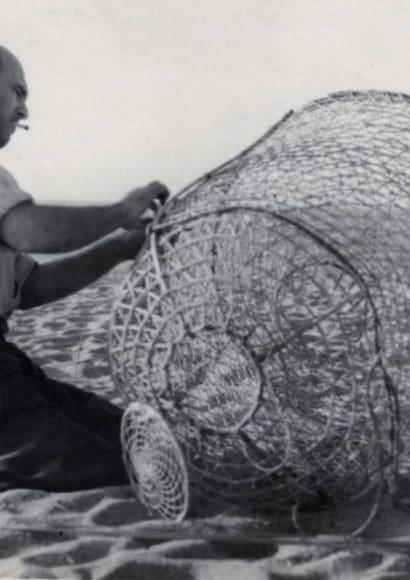
Fishing has been a cornerstone of human survival and culture for thousands of years. From the earliest days of our existence, humans have relied on their ingenuity to devise tools and techniques to catch fish, a vital source of food. The oldest fishing tools provide a fascinating glimpse into the past, showcasing the resourcefulness and adaptability of our ancestors. These ancient implements, ranging from primitive hooks and spears to intricate nets and traps, not only reveal the technological advancements of early societies but also their deep connection to the natural world.
By examining these ancient tools, we gain insight into the evolution of fishing techniques and the enduring legacy of our quest to harvest the bounty of the waters. This article delves into the history of the oldest fishing tools, exploring their origins, uses, and impact on both ancient and modern fishing practices.
Contents
The Origins of Fishing.🐟
Early Evidence of Fishing
Fishing is one of humanity’s oldest activities, dating back thousands of years. Early humans quickly realized that water bodies were rich sources of food. Archaeologists have discovered the oldest fishing tools at ancient sites, revealing how our ancestors relied on fishing for survival.
The oldest fishing tools found include primitive hooks made from bones, shells, and wood. These tools date back around 23,000 years and show that early humans were highly skilled at catching fish. They also used simple nets woven from plant fibers to capture multiple fish at once. Fish bones and ancient fishing gear found in archaeological digs provide compelling evidence of how vital fishing was to early human communities.
Significance of Fishing in Ancient Cultures.
Fishing was not just about survival; it played a significant role in the culture and economy of ancient societies. Communities living near rivers, lakes, and seas developed specialized fishing techniques suited to their environments. These techniques were passed down through generations, becoming integral to their way of life.
In ancient Egypt, for example, fishing was an essential part of daily life and trade. Fishermen used nets, traps, and harpoons to catch fish from the Nile. Similarly, in ancient China, people developed unique fishing methods and tools, such as bamboo rods and silk lines. These innovations reflect the importance of fishing in these cultures.
Importance of Fish in Ancient Diets.
Fish was a staple in ancient diets, providing essential nutrients and protein. It was often easier to catch fish than to hunt land animals, making it a reliable food source. Different regions had their own preferred fish species, like the Surubí fish in South America.
5 recipes with Surubí fish have been found in ancient texts, showcasing how diverse and creative ancient cooking methods were. Surubí fish was prepared in various ways, such as grilling, smoking, and stewing, highlighting its importance in the diet of these cultures.
Impact on Modern Fishing
The techniques and tools developed by our ancestors laid the foundation for modern fishing. Many of today’s fishing methods are rooted in ancient practices. By understanding the oldest fishing tools, we gain insight into how fishing has evolved over millennia.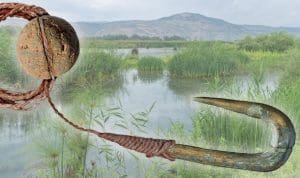
The legacy of these ancient tools is still evident today. For example, modern fish hooks, nets, and traps are more advanced but follow the same basic principles. This continuity highlights the ingenuity and resourcefulness of early humans in developing tools that have stood the test of time.
Ancient Fishing Tools.🐟
Hooks.
One of the oldest fishing tools ever discovered is the fish hook. Early humans crafted these hooks from bones, shells, and even wood. These primitive hooks date back around 23,000 years. Their discovery shows us just how innovative early humans were.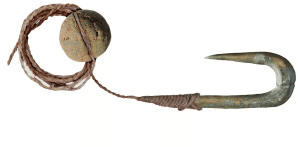
Fish hooks were vital for catching fish individually. They allowed fishermen to target specific fish species, increasing their chances of a good catch. Early hooks were often barbed, making it harder for fish to escape. Today, many modern fish hooks still follow these ancient designs, proving their effectiveness.
Nets and Traps.
Another crucial tool in ancient fishing was the net. Nets were made from plant fibers, such as flax or hemp, twisted into strong, flexible strands. These nets could catch many fish at once, making them an efficient tool for early fishermen.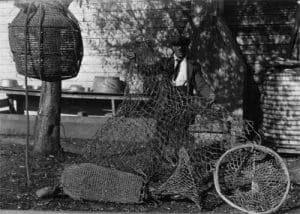
Ancient people also used fish traps. These traps were often made from sticks and reeds, forming barriers in rivers or tidal areas. Fish would swim into these traps and find it difficult to escape. Such traps were highly effective and are still used in some traditional fishing communities today.
The Evolution of Fishing Tools.🐟
Materials and Technology.
Fishing tools have come a long way since ancient times. The oldest fishing tools were made from natural materials like bone, wood, and plant fibers. These materials were abundant and easy to shape into useful tools. Over time, as human societies advanced, so did the materials and technology used in fishing.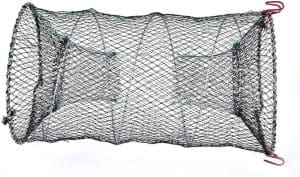
The invention of metal tools marked a significant leap in fishing technology. Bronze and iron hooks were stronger and more durable than their bone and wood predecessors. Metal tools could be crafted with greater precision, making fishing more efficient. Today, modern fishing tools use advanced materials like stainless steel, nylon, and carbon fiber, which are lightweight, strong, and resistant to corrosion.
Modern fishing also benefits from technological advancements. For instance, fish finders and GPS systems help fishermen locate schools of fish with ease. While the basic principles of fishing remain the same, these technological tools have revolutionized the practice, making it more efficient and productive.
Cultural Variations.
Different cultures have developed unique fishing tools and methods, reflecting their environments and resources. For example, in Polynesia, fishermen used finely crafted lures and canoes to catch fish in the vast Pacific Ocean. These lures, often made from shells and bones, were designed to mimic the appearance and movement of small fish, attracting larger prey.
In ancient Egypt, fishing was a vital part of daily life along the Nile River. Egyptians used nets, traps, and even fishing rods made from reeds. Fish were a major food source, and recipes for preparing fish like 5 recipes with Tilapia fish have been found in ancient texts. These recipes show how important and versatile fish was in their diet.
requently Asked Questions About Ancient Fishing Tools.🐟
What are the oldest fishing tools ever discovered?
The oldest fishing tools ever discovered include primitive fish hooks, spears, and nets. The oldest known fish hooks, made from bones and shells, date back around 23,000 years and were found in East Timor. Spears and harpoons crafted from bone and stone date back even further, providing evidence of early humans fishing in lakes and rivers. These discoveries highlight the long history and importance of fishing in human survival and development.
How did ancient civilizations fish?
Ancient civilizations employed various fishing techniques tailored to their environments and available resources. They used:
- Hooks and lines: Early fish hooks were made from bone, shell, and wood.
- Nets: Woven from plant fibers or animal sinew, nets were used to capture multiple fish at once.
- Traps and weirs: Structures built from sticks and reeds to funnel fish into enclosed areas.
- Spears and harpoons: Used for both fishing and hunting larger marine animals.
- Boats and rafts: Crafted from wood or reeds to fish in deeper waters. These methods were refined over time, showcasing the ingenuity and adaptability of ancient peoples.
What materials were used to make the earliest fishing tools?
The earliest fishing tools were made from materials readily available in nature. These included:
- Bone: Used for making fish hooks, spears, and harpoon points due to its durability and ease of shaping.
- Wood: Crafted into fishing rods, spears, and components of traps and weirs.
- Shell: Fashioned into sharp hooks and barbs.
- Plant fibers: Woven into nets and lines for their strength and flexibility.
- Stone: Shaped into weights for nets and spearheads. These materials were chosen for their availability and effectiveness in capturing fish, allowing early humans to develop diverse and efficient fishing tools.


